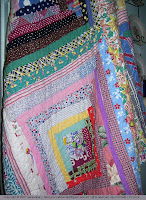After doing some intensive research both on the internet and in my own collection of books, I have some things to add to what I wrote earlier this week about boats on Little River in Christian County, Kentucky.
First of all, I found out that the Little River clipping I quoted in my previous post had a few words left out of it. The 1811 act that declared Little River a navigable stream of Christian County, KY, actually said that it could not be obstructed from its mouth to "the mouth of sinking fork of said river." The Sinking Fork comes into Little River a few miles southeast of Cadiz (about 15 miles west of Hopkinsville).
Also, I came to realize that in 1811, Trigg County had not yet been created. It was still part of Christian County. So, what the legislature was calling Christian County in 1811 is not the same as what we call Christian County, today.
An 1815 act of the Kentucky legislature established Steel's Mill as the terminus of the portion of Little River that was reserved for navigation. I haven't been able to learn the location of Steel's Mill, but I think it might have been somewhere near the confluence of the Sinking Fork and Little River. Smaller boats could still have been used above that point; however, the river could be obstructed by foot bridges, mill dams, and the like. (I read about one family who drowned while crossing Little River in a flatboat. Their boat was carried over a mill dam.)
One fellow, a Mr. Samuel Alexander who moved into the Newstead or Julien area of Christian County (south of Gracey) in 1808, shipped farm goods regularly by flatboat, presumably taking the Little River to the Cumberland. William Henry Perrin's 1884 History of Christian County, Kentucky says that Alexander "made frequent trips to New Orleans with flat-boat loads of tobacco and other produce. On one occasion, he extended his trip as far as Santa Fe, New Mexico, taking out goods on pack-mules, which he bartered for mules and mustang ponies."
Cadiz (about 20 miles west of Hopkinsville on a rough and muddy stagecoach road that started as an Indian trail) was a river-shipping center until the railroad came to Hopkinsville. Perrin wrote in the 1884 History of Trigg County, Kentucky that: "[Little River] is the crookedest stream perhaps in the world, and flows to every point of the compass sometimes within the distance of a mile. At one time it was considered a navigable stream, and small boats came up as far as Cadiz. Efforts have been made to obtain an appropriation from the National Government for its improvement, but the fact of its location south of Mason and Dixon's line has so far defeated the laudable undertaking."
Perrin also wrote, "Mr. Robert Baker had a rudely constructed warehouse [in or near Cadiz] which he kept for storing tobacco, and himself and brother and Silas Alexander usually shipped the entire lot in flat-boats up to about 1837 to 1841, their principal market being New Orleans. About this time the tobacco business attracted the attention of gentlemen possessed of means, better credit and a more comprehensive business capacity. and the old shipping system was compelled to give way to the buyers and professional tobacconists."
According to Gail King's entry about flatboats in the Kentucky Encyclopedia, they were sometimes as small as 12 feet wide and 20 feet long. Other sources mention flatboats 10 feet in width in use on smaller streams. When Little River's waters were high, I believe the stream's width and depth would have been more than adequate for small flatboats, even above the Sinking Fork confluence.
An 1891 report on Christian County by the Kentucky Dept of Agriculture noted, "Excellent water-power for mills, or other manufacturing purposes, is afforded by Little river, West Fork, Pond river and other streams. None, however, are navigable for steamboats. If cleaned out, some of them might be available for rafts and flat-boats."
I don't know how many early settlers tried to sail flatboats or other watercraft down the narrower, shallower stretches of Little River and other Christian County streams. However, those pioneers who settled near the rivers saw them as a means of transportation in a wilderness without roads. If they didn't go downriver themselves with their goods, they commissioned or sold to someone who was making a river trip. That's how interstate commerce operated in Kentucky at that time.
Many flatboats ended up in New Orleans, but it was also common to stop along the shore to sell to Southern plantations along the way. The residents of the Deep South were happy to buy Kentucky goods like sorghum, potatoes, corn, whiskey, flour, pork, and of course, tobacco. Even the flatboat was sold at the end of the journey; the lumber brought a good price in New Orleans. The return trip to Kentucky was often made overland, over the Natchez Trace, or sometimes the rivermen returned to Kentucky by steamboat. (Steamboats were running the Mississippi before 1820.)
The importance of the rivers to the early settlers of Christian County is demonstrated by the tax records of 1800. Each taxpayer's record includes the name of the stream on which he lives.
In this drawing, a large flatboat occupies the foreground.
It's riding the river current, headed downstream. Its crew
is steering it away from sandbars and other obstructions.
In the background, men are poling a keelboat upstream.















